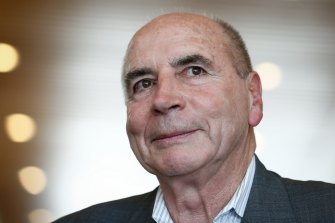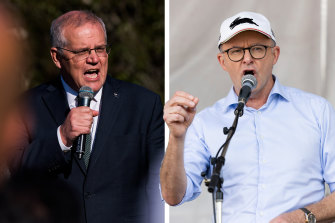Don’t ‘pussyfoot around’: Fraser says RBA has to start lifting rates now
The Reserve Bank should not “pussyfoot around” with a small interest rate rise on Tuesday, former governor Bernie Fraser says, arguing it has to move quickly to dampen inflation pressures being fed by loose fiscal policy and spending promises made during the election campaign.
Fraser, who lifted interest rates by 2.75 percentage points in 1994, which former prime minister Paul Keating said contributed to his 1996 election loss, said it was clear there was too much “stimulation” in the economy and the RBA needed to tackle it sooner rather than later.
Former Reserve Bank governor Bernie Fraser says the RBA should not “pussyfoot around” but lift rates by half a percentage point on Tuesday to quell inflation pressures.Credit:Alex Ellinghausen
A half percentage point increase would add $211 a month to the repayments on an $800,000 mortgage.
The RBA board meets on Tuesday and financial markets and most economists expect it to lift the cash rate by 0.15 percentage points to 0.25 per cent. It would be the first rate increase since November 2010 and the first in an election campaign since 2007.
Both sides of politics, fighting a campaign dominated by cost-of-living issues, are bracing for a rate rise that markets and economists say will be the first in a series of increases that could take the cash rate towards 2 per cent by the end of the year.
Fraser said it was clear that the circumstances required action by the RBA and the central bank should start normalising interest rates quickly.
“I don’t think the bank can pussyfoot around. I think it should go with a 50 basis point increase. That means it doesn’t have to move so hard later on,” he said.
The last time the bank lifted interest rates by more than a quarter percentage point was in 2000. A 50 basis point rise would take the cash rate from 0.1 per cent to 0.6 per cent.
Prime Minister Scott Morrison, who has said interest rates would be lower under his government than under Labor, warned journalists on Monday not to politicise the potential rate rise.
“It’s not about politics. What happens tomorrow deals with what people pay on their mortgages. That’s what I’m concerned about. It’s not about what it means for politics,” he said.
An interest rate rise from the Reserve Bank will be a key debating point for Scott Morrison and Anthony Albanese through the rest of the election campaign.Credit:James Brickwood, Alex Ellinghausen
But Fraser said it was clear the economy, with unemployment at 4 per cent and inflation at 5.1 per cent, could withstand a cash rate above an “unsustainably low” 0.1 per cent.
He said both sides of politics were facing a rude shock after the May 21 poll given their election agendas were focused on pumping more money into the economy.
“There’s a lot of stimulation around; there’s the fiscal stimulus there and then every day there’s a promise in the election campaign to spend more,” Fraser said.
“I don’t think either side, no matter who gets back into power, really knows what’s coming. They’re more focused on winning rather than what’s good for the economy and what’s good for the
community.”
Morrison, campaigning in Victoria, said there were pressures coming from outside of Australia on the nation’s interest rate settings.
He said the current rate of 0.1 per cent was “unconventionally low” and taxpayers understood that it would start to move up.
“The pressures on interest rates … the pressures on cost of living, highlight just why the economy is so important in this election,” Morrison said.
But shadow treasurer Jim Chalmers said if rates were increased on Tuesday, it would be an indictment of the government’s economic management.
“This is the third wave of Scott Morrison’s cost-of-living crisis,” Chalmers said. “This is a triple whammy of falling real wages, skyrocketing inflation and interest rates are about to rise as well.
“Australians can’t risk, and they can’t afford, another three years of being absolutely punished by Scott Morrison’s failures on the economy.”
ANZ economist Adelaide Timbrell said even if interest rates increased on Tuesday, many home buyers would barely notice the change.
She said 40 per cent of people had held their mortgage repayments at the level they were before the RBA started cutting rates. The proportion of people with high debts and low repayment buffers was lower now than before the COVID-19 recession.
While many expect the RBA to lift rates, KPMG senior economist Sarah Hunter said there were still good reasons for the bank to wait until June and then lift rates by 0.4 percentage points.
“A June increase would allow the RBA to act outside the election campaign, and with the benefit of seeing the wage price index released in mid-May before deciding on the size of the upward movement,” Hunter said.
The cash rate, set by the RBA, is effectively the price of money in Australia. It sets the level of every other interest rate, including mortgage rates, which also include a commercial bank’s profit and the risk of a home buyer failing to pay back their loan.
Cut through the noise of the federal election campaign with news, views and expert analysis from Jacqueline Maley. Sign up to our Australia Votes 2022 newsletter here.
Most Viewed in Politics
From our partners
Source: Read Full Article

